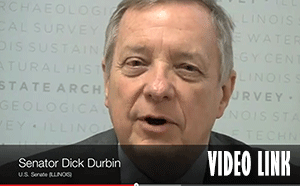ISTC NEWS
Nanoparticle Membrane Technology Investigated for Commercial Viability

ISTC’s Nandakishore Rajagopalan and Wei Zheng are part of a team of experts from government and academia who are working to improve the filtration of household drinking water using new ultrathin nanoparticle-based membranes to remove trace organic contaminants (TrOCs).
The U.S. Department of Energy will fund the work through its Technology Commercialization Fund, which moves promising energy technologies developed by 12 national laboratories and their research partners to the marketplace. ISTC will assist in the testing the performance of prototype TrOCs filtration membrane devices which may be commercially viable for the home water filtration market. The primary investigator on the project is Xiao-Min Lin, a scientist at Argonne’s Center for Nanoscale Materials and at the James Franck Institute, University of Chicago.
Argonne National Laboratory and the University of Chicago developed the technology for the new membrane structure using gold nanoparticles which are strong and porous, and which can be ‘dialed’ to selectively trap different contaminants by engineering the ligand on the particle surface. A ligand is a molecule that binds to a central metal atom to form a complex that helps to protect the nanoparticle and introduce additional functionalities. Laboratory measurements have demonstrated the nanoparticle based membrane can selectively filter out molecules as small as 2 micrometers, yet has water permeability far higher than conventional polymer-based membranes.
For two years, scientists at Argonne, ISTC and the Metropolitan Water Reclamation District (MWRD) of Greater Chicago have been conferring on the problem of removing TrOCs from potable water supplies. Such contaminants consist of hormones, pesticides, prescription medications, personal care products, synthetic industrial chemicals, and chemicals formed during wastewater and drinking-water treatment processes. Even at very low concentrations these molecules can negatively affect aquatic environments and are of concern for human health impacts.
“Modern wastewater treatment plants were not designed to remove such materials, especially at such low concentrations,” said Wei Zheng, a senior research scientist at ISTC.
The search has been ongoing for methods to remove TrOCs including biodegradation, photolysis, volatization, and sorption. “We hope a gold nanoparticle-based membrane approach will improve the sorption efficiency of TrOC removal at low pressure and low energy — at a cost that makes it widely available for home filtration,” he said.
“Deploying new clean energy technologies is an essential part of our nation’s effort to lead in the 21st century economy and in the fight against climate change,” said Lynn Orr, DOE’s Under Secretary for Science and Energy in announcing the grant. DOE’s Technology Commercialization Fund “will help to accelerate the commercialization of cutting-edge energy technologies developed in our national labs, making them more widely available to American consumers and businesses.”











